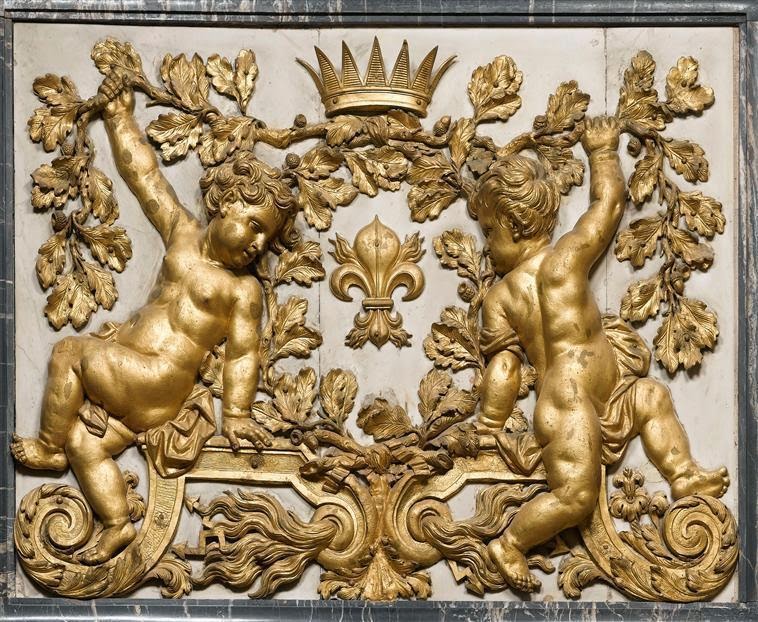The Pavillon of Belvedere situated on a pond over looking the English garden next to a stone grotto
Marie Antoinette is the only queen to have imposed her personal taste on Versailles in a grand style. Sweeping away the old court and its ancient traditions, she insisted on living as she wished. In her Trianon domain, which Louis XVI gave her in 1774, she found the heaven of privacy that enabled her to escape from the rigours of court etiquette. Nobody could come there without her invitation.
Marie Antoinette and children happy in the gardens of the Petite Trianon
The octagonal carved marble Belvedere was use as a teahouse where Marie Antoinette served tea, her self. Situated on a pond over looking the English garden next to a stone grotto, It was a favorite entertainment place for Marie Antoinette and her court. This building is a perfect illustration of the 18th century’s taste for picturesque compositions combining decorative gardens and architecture.The octagonal Belvedere was built between (1778-81), and consecrated to the four Seasons, in the newly-informal gardens of the Petit Trianon at Versailles.
The octagonal Belvedere was built between (1778-81), and consecrated to the four Seasons
The octagonal Belvedere was built between (1778-81), and consecrated to the four Seasons
Salon du Rocher with stucco walls highlighted by arabesque and floral patterns are rounded off by polychrome marble tiles.
Salon du Rocher with stucco walls highlighted by arabesque and floral patterns
Salon du Rocher with stucco walls highlighted by arabesque and floral patterns
Salon du Rocher with stucco walls highlighted by arabesque and floral patterns
Furnishing the Pavillion of the Belvedere. The furnishing of the Belvedere was some of the most expensive items Marie Antoinette ordered. The pieces are very will documented as the original bills exist in the Archives Nationale in Paris. and were used in her trial during the French Revolution. In 1780, François Foliot made eight gilt wood armchairs and eight side chairs, designed in the Neoclassical style with carved bands of ivy, laurel wreaths, and fluting, they stood in the salon du Rocher of the Belvedere Pavilion, designed by Jacques Gondoin. This was one of Foliot’s last commissions before being replaced in the Queen’s favor by Georges Jacob. It is possible that the sculptor of the beautiful hymen’s torch uprights on the back and the pierced seat rail were sculpted by Foliot’s uncle, Nicolas Quinibert Foliot. What made this seating furniture so expensive was the hand embroidered gold and silver threads on a cream background.
Chair from the Belvedere Pavilion, 1782, Francois Foliot II (1748–after 1808), carved and gilded beech, original upholstery
Chair from the Belvedere Pavilion, 1782, Francois Foliot II (1748–after 1808), carved and gilded beech, modern upholstery
Chair from the Belvedere Pavilion, 1782, Francois Foliot II (1748–after 1808), carved and gilded beech, modern upholstery
An armchair designed by Foliot for Marie Antoinette. This is the sole survivor of a suite of eight armchairs for which the bills exist in the Archives Nationale. The carving and gently curving back reflects the decorative scheme devised by the architect Gondoin for the circular Pavilion in the grounds of the Petite Trianon.
Cups and saucers from my collection ordered by Marie Antoinette from her porcelain factory in Paris Rue Thiroux.
Instead of ordering porcelain from the Royal porcelain factory of Sèvres. Marie Antoinette ordered porcelain from her porcelain factory in Paris under André Leboeuf on rue Thiroux. She chose a pattern that complimented her marble mosaic tile floor in interlocking semicircle and stair pattern. I'm lucky to own five tea cups and saucers ordered and used by Marie Antoinette in her grand circular Salon du Rocher in the Pavillion of the Belvedere at Versailles! As it is known that Marie Antoinette served tea herself in this elegant salon, so Marie Antoinette touch my cups! I like to think about what was talked about over a nice cup of hot tea with Marie Antoinette and friends.
Cups and saucers from my collection ordered by Marie Antoinette from her porcelain factory in Paris Rue Thiroux. The cups and saucers have a pattern that resemble the marble mosaic tile floor in interlocking semicircle and stair pattern.
Cups and saucers from my collection ordered by Marie Antoinette from her porcelain factory in Paris Rue Thiroux. The cups and saucers have a pattern that resemble the marble mosaic tile floor in interlocking semicircle and stair pattern.
Cups and saucers from my collection ordered by Marie Antoinette from her porcelain factory in Paris Rue Thiroux with the Crowned A mark for Marie Antoinette
































Awesome shower project collection. Check our shower corner self
ReplyDelete